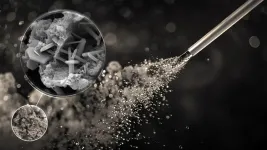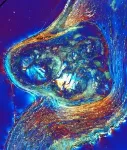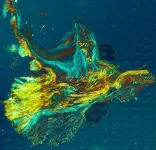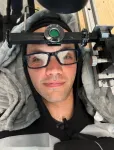(Press-News.org)
By using a carbonated — rather than a still — water-based solution during the concrete manufacturing process, a Northwestern University-led team of engineers has discovered a new way to store carbon dioxide (CO2) in the ubiquitous construction material.
Not only could the new process help sequester CO2 from the ever-warming atmosphere, it also results in concrete with uncompromised strength and durability.
In laboratory experiments, the process achieved a CO2 sequestration efficiency of up to 45%, meaning that nearly half of the CO2 injected during concrete manufacturing was captured and stored. The researchers hope their new process could help offset CO2 emissions from the cement and concrete industries, which are responsible for 8% of global greenhouse gas emissions.
The study was published today (June 26) in Communications Materials, a journal published by Nature Portfolio.
“The cement and concrete industries significantly contribute to human-caused CO2 emissions,” said Northwestern’s Alessandro Rotta Loria, who led the study. “We are trying to develop approaches that lower CO2 emissions associated with those industries and, eventually, could turn cement and concrete into massive ‘carbon sinks.’ We are not there yet, but we now have a new method to reuse some of the CO2 emitted as a result of concrete manufacturing in this very same material. And our solution is so simple technologically that it should be relatively easy for industry to implement.”
“More interestingly, this approach to accelerate and accentuate the carbonation of cement-based materials provides an opportunity to engineer new clinker-based products where CO2 becomes a key ingredient,” said study coauthor Davide Zampini, vice president of global research and development at CEMEX.
Rotta Loria is the Louis Berger Assistant Professor of Civil and Environmental Engineering at Northwestern’s McCormick School of Engineering. The study was a collaboration between Rotta Loria’s laboratory and CEMEX, a global building materials company dedicated to sustainable construction.
Limitations of previous processes
A non-negotiable part of infrastructure, concrete is one of the world’s most consumed materials — second only to water. To make concrete in its simplest form, workers combine water, fine aggregates (like sand), coarse aggregates (like gravel) and cement, which binds all the ingredients together. Since the 1970s, previous researchers have explored various ways to store CO2 inside concrete.
“The idea is that cement already reacts with CO2,” Rotta Loria explained. “That’s why concrete structures naturally absorb CO2. But, of course, the absorbed CO2 is a small fraction of the CO2 emitted from producing the cement needed to create concrete.”
Processes to store CO2 fall into one of two categories: hardened concrete carbonation or fresh concrete carbonation. In the hardened approach, solid concrete blocks are placed into chambers where CO2 gas is injected at high pressures. In the fresh version, workers inject CO2 gas into the mixture of water, cement and aggregates while concrete is being produced.
In both approaches, some of the injected CO2 reacts with the cement to become solid calcium carbonate crystals. Both techniques, however, share deal-breaking limitations. They are hindered by low CO2 capture efficiency and high energy consumption. Even worse: The resulting concrete is often weakened, hampering its applicability.
Uncompromised strength
In Northwestern’s new approach, the researchers leveraged the fresh concrete carbonation process. But, instead of injecting CO2 while mixing all the ingredients together, they first injected CO2 gas into water mixed with a small amount of cement powder. After mixing this carbonated suspension with the rest of the cement and aggregates, they achieved a concrete that actually absorbed CO2 during its manufacturing.
“The cement suspension carbonated in our approach is a much lower viscosity fluid compared to the mix of water, cement and aggregates that is customarily employed in present approaches to carbonate fresh concrete,” Rotta Loria said. “So, we can mix it very quickly and leverage a very fast kinetics of the chemical reactions that result in calcium carbonate minerals. The result is a concrete product with a significant concentration of calcium carbonate minerals compared to when CO2 is injected into the fresh concrete mix.”
After analyzing their carbonated concrete, Rotta Loria and his colleagues found its strength rivaled the durability of regular concrete.
“A typical limitation of carbonation approaches is that strength is often affected by the chemical reactions,” he said. “But, based on our experiments, we show the strength might actually be even higher. We still need to test this further, but, at the very least, we can say that it’s uncompromised. Because the strength is unchanged, the applications also don’t change. It could be used in beams, slabs, columns, foundations — everything we currently use concrete for.”
“The findings of this research underline that although carbonation of cement-based materials is a well-known reaction, there is still room to further optimize the CO2 uptake through better understanding of the mechanisms tied to materials processing,” Zampini said.
The study, “Storing CO2 while strengthening concrete by carbonating its cement in suspension,” was supported by CEMEX Innovation Holding Ltd.
END
Disability studies has gained prominence in recent years, transforming fields ranging from design to literary studies with insurgent approaches to access and representation. The newest volume of Osiris, “Disability and the History of Science,” extends this movement to ask how disability has been a central, if unacknowledged, force in the scientific disciplines and the history of science. The volume examines the many roles that disability and disabled people have played throughout the history of science, calling attention to the shaping of scientific knowledge production by disability.
Editors Jaipreet Virdi, Mara Mills, and Sarah F. Rose, in their introduction ...
AlphaFold is an outstanding example of artificial intelligence’s computational capabilities in accurately predicting intricate protein structures. A new Review article explores AlphaFold’s recent advancements and its potential impact on predictive medicine. The article is published in the peer-reviewed journal AI in Precision Oncology. Click to read the articles now.
Vivek Subbiah, MD, from the Sarah Cannon Research Institute, and coauthors, describe a shift toward predictive medicine, in which AI, integrated with genomic data, ...
CHAMPAIGN, Ill. — The human body has sophisticated defenses against the deposition of calcium minerals that stiffen heart tissues, researchers at the University of Illinois Urbana-Champaign and collaborators at UCLA Health and the University of Texas at Austin found in a new study that provides the first detailed, step-by-step documentation of how calcification progresses.
“Heart disease is the leading killer annually — about 18 million deaths per year — and that number is growing. A large proportion is the result of calcification,” said study leader Bruce Fouke, a U. of I. professor of earth ...
Quantum computers have the potential to be revolutionary tools for their ability to perform calculations that would take classical computers many years to resolve.
But to make an effective quantum computer, you need a reliable quantum bit, or qubit, that can exist in a simultaneous 0 or 1 state for a sufficiently long period, known as its coherence time.
One promising approach is trapping a single electron on a solid neon surface, called an electron-on-solid-neon qubit. A study led by FAMU-FSU College of Engineering Professor Wei Guo that was ...
(Boston) — AL (immunoglobulin light chain) amyloidosis is a rare disease that often results in progressive organ dysfunction, organ failure and eventual death.
Clonal plasma cells in the bone marrow secrete free light chains into circulation. These light chains are part of immunoglobulins, also called antibodies. But in this disease, light chains misfold and aggregate into amyloid fibrils that deposit in organs and tissues.
In a review article of AL amyloidosis “Systemic Light Chain Amyloidosis,” Vaishali Sanchorawala, MD, director of the Amyloidosis Center at the Chobanian & ...
Excessive heat across the United States is making this summer a season of sweat. Perspiration and its evaporation are crucial to keeping us cool when things get hot. But our understanding of how sweat evaporates is limited to the profuse phases of the process, when our bodies are coated in a sticky film or even pools of perspiration. Relatively is little is known about the dynamics behind initial phases of sweating, when tiny droplets are emitted by individual sweat glands and then quickly evaporate.
“There are mechanical engineering researchers around the world, myself included, who are devoted to understanding the different parameters of droplet behavior on ...
Newly published research from Colorado State University answers fundamental questions about cellular connectivity in the brain that could be useful in the development of treatments for neurological diseases like autism, epilepsy or schizophrenia.
The work, highlighted in the Proceedings of the National Academy of Sciences, focuses on how neurons in the brain transmit information between each other through highly specialized subcellular structures called synapses. These delicate structures are key to controlling many processes across the nervous system via electrochemical ...
WASHINGTON – The U.S. Naval Research Laboratory’s (NRL) Compact Coronagraph (CCOR) was launched June 25, on the National Oceanic and Atmospheric Administration (NOAA) Geostationary Operational Environmental Satellite-U (GOES-U) from NASA – Kennedy Space Center to detect and characterize coronal mass ejections (CMEs).
The NOAA sponsored NRL to design, integrate, and test CCOR, a small space telescope that will create an artificial eclipse of the sun and ...
DURHAM, N.C. – While the liver is one of the body’s most resilient organs, it is still vulnerable to the ravages of stress and aging, leading to disease, severe scarring and failure. A Duke Health research team now might have found a way to turn back time and restore the liver.
In experiments using mice and liver tissue from humans, the researchers identified how the aging process prompts certain liver cells to die off. They were then able to reverse the process in the animals with an investigational drug.
The finding, which ...
A study conducted by researchers at Baylor College of Medicine and collaborating institutions reveals the molecular events leading to osteogenesis imperfecta type V, a form of brittle bone disease caused by a mutation in the gene IFITM5.
The mutation blocks the normal development of bone stem cells into mature cells, which would form healthy bones. Instead, the mutation leads to the formation of bones that are extremely brittle. Children with this disorder have recurrent fractures, bone deformities, chronic pain and other complications. ...







